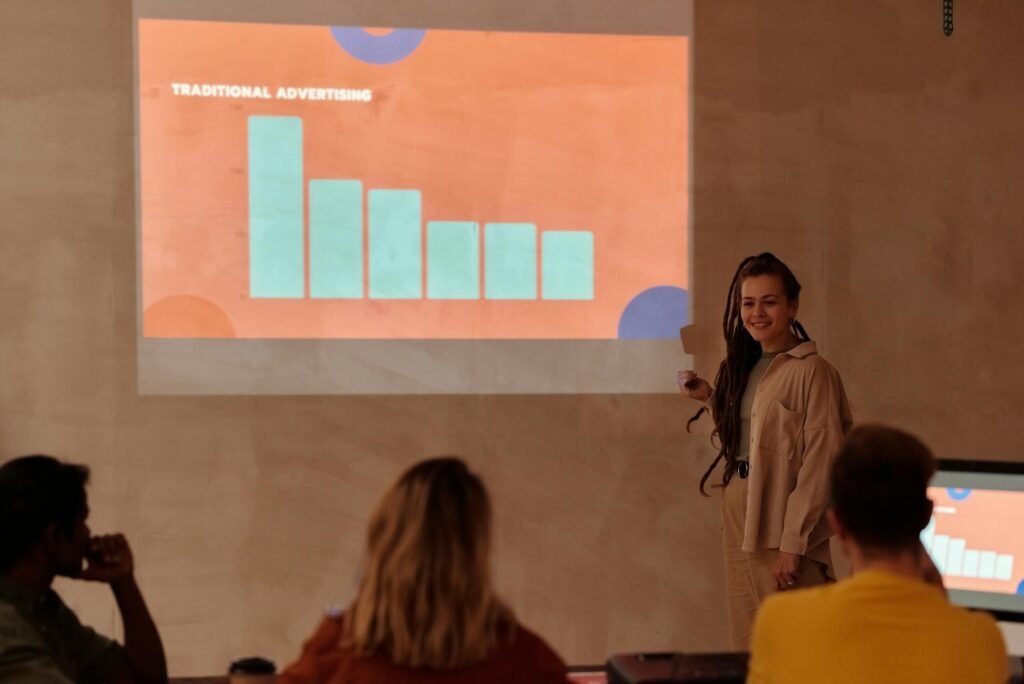Understanding Inbound Marketing
Let me break down how I use inbound marketing. Think of it as a friendly conversation rather than shouting through a megaphone hoping someone listens. Instead of bombarding everyone and their grandma with ads, I craft content that’s genuinely useful and matches what people are looking for. It’s like fishing with a rod where potential customers are drawn to the good stuff we put out there, and yep, that’s pretty different from the noisy world of outbound marketing where stuff is just smeared everywhere without a care.
Definition and Key Concepts
Okay, so what exactly is inbound marketing, right? It’s like throwing a welcome party where everyone leaves with something useful. It’s about creating materials that naturally pull folks in, sort of like the Pied Piper but with good intentions. Think of content marketing as its cousin which can take loads of forms: blogs, infographics, podcasts, and even webinars that I churn out to keep things lively and informative.
Here’s how it all fits together:
| Concept | Description |
|---|---|
| Attraction | Making snazzy content that makes folks want to check out your site like they just found a new favorite book. |
| Engagement | Chatting it up and delivering juicy insights that keep potential customers curious and satisfied. |
| Delight | Keeping that warm fuzzy feeling alive, ensuring folks leave happy and want to come back for more. |
Benefits of Inbound Marketing
The perks of playing the inbound game are big. By getting people to want to listen instead of just cutting in, businesses can form better friendships and a loyal gang of followers.
Here are some of those perks you might dig:
| Benefit | Description |
|---|---|
| Cost-Effectiveness | Cheaper than the traditional shouting ads, keeping the wallet happy too. |
| Quality Leads | Attracts folks who are already snooping for your stuff, so it’s a win-win with higher chances of sealing the deal. |
| Brand Authority | Gives you street cred as the go-to guru in the field when you dish out valuable nuggets of wisdom. |
| Long-Term Results | Like a fine wine, good content gets better with age, pulling in more folks even down the road. |
Switching gears to an inbound-heavy plan is a smart move. The suggestion is dumping the old ways that leaned 90% on outbound malarkey to more inbound love. Check out our piece on inbound marketing examples to see how it all clicks into place.
Inbound Marketing Strategy
Let’s talk about the kind of marketing strategy that doesn’t shout, but rather whispers sweet value into your potential customers’ ears. Yep, we’re talking about inbound marketing. It’s all about giving folks the good stuff they’re already on the lookout for and making sure they know you’re the real deal.
The Four Stages
My plan of attack in the world of inbound is wrapped around four main stages: Attract, Convert, Close, and Delight. Every single stage is a step in leading possible customers from a curious glance to a full-on fan.
| Stage | Description |
|---|---|
| Attract | Think of this as casting your line out to a lake full of hungry fish. You’re using nifty content like blogs, cool videos, and snazzy social media posts to hook ’em. We’re reeling in folks who are already on the hunt for what you got. |
| Convert | Next, it’s time to swap greetings with those curious wanderers. We take ’em by the hand and transform them into proper leads. We’re gathering up necessary info via those tempting CTAs (Calls to Action), sleek forms, and eye-catching landing pages. |
| Close | Now, we’re talking business. We’re working to seal the deal and welcome newbies as part of the family. Shoot out tailored content to tackle their specific hurdles and see that signature on the dotted line. |
| Delight | Wrap up their visit with such a cherry on top they can’t help but come back for seconds. Provide ongoing love with support and useful content that’ll make repeat customers and create word-of-mouth champions out of ’em. |
Every part of this sets up a no-muss, no-fuss way to inbound marketing that ticks the boxes of what customers wish for (Responsify).
Customer-Centric Approach
Instead of yapping like the typical loudspeaker of old-school marketing, inbound marketing is more like a good friend who’s got the right thing to say. We’re giving people content that’s like a key they’re looking for to unlock what they need online.
This way of doing things builds bridges of trust and spins a web of engagement. Your content pops up just when your peeps are hunting for answers. Feels less like a sales pitch and more like a helping hand (Responsify).
Using this customer-focused vibe lets me gel with folks on a more meaningful level. I’m all about solving problems and showcasing how what I offer makes life easier. When I roll out killer content chock-full of education (inbound marketing examples), it’s like laying a comfy red carpet for customers to keep coming back.
In conclusion, when you build this kind of solid inbound strategy with customers at the heart of it all, magic happens. Relationships built on this are strong and have legs to run the distance. This method makes sure my efforts are right on target to attract, grab the attention of, and keep the love of my dream audience.
Importance of Knowing Your Audience
Getting to know your audience is no joke in digital marketing. It helps me whip up content that doesn’t just tick the boxes but hits all the right notes with the folks I want to reach. By getting a handle on what they like, what bugs them, and what makes them tick, I can roll out stuff that feels like it was made just for them. Throwing tools like market research and cooking up buyer personas into the mix is a game changer for this.
Creating Buyer Personas
The secret sauce you need in inbound marketing? Buyer personas. Not crafting detailed personas is a rookie mistake that can throw a wrench in the works for marketing campaigns. To dodge this, I dive deep into research to build spot-on target personas using both demographic dope and the way folks think (LeadG2).
Here’s a quick guide to piecing together killer buyer personas:
| Persona Element | Description |
|---|---|
| Name | Give your persona a fictional name for easy reference. |
| Demographics | Stuff like age, gender, money situation, schooling, location. |
| Job Title | Usual gigs they hold in their line of work. |
| Goals | What dreams or targets do they have? |
| Challenges | Stuff that gets in their way or bugs them. |
| Preferred Content | Type of content they’re into (blogs, videos, etc.)? |
| Buying Triggers | What gets them to splurge or make a purchase? |
Getting these personas right makes sure that when I’m making content, it’s locked and loaded to tackle the real issues, making marketing efforts click (Plezi).
Market Research Tools
Using market research tools is like having a secret weapon up my sleeve for sizing up my audience. These nifty tools let me in on how the audience behaves, their likes and dislikes, and what’s trending. Some standout tools are:
- Surveys and Polls: Straight talk from the horse’s mouth – direct customer feedback.
- Google Analytics: Peep into website traffic and how users engage with content.
- Social Media Insights: Check out who’s watching and what they’re doing on social media platforms.
- Customer Interviews: Real talk directly with the people I aim to serve.
These tools help me to tweak and fine-tune buyer personas and keep my inbound marketing strategies sharp. The more I nail my persona accuracy, the better I can gear up to meet the audience’s needs and hit it big in inbound marketing.
Hungry for more tips on nailing these strategies? Check out the scoop on inbound marketing strategies or find some cool inbound marketing examples.
Planning an Effective Inbound Funnel
Creating a killer inbound sales funnel’s all about steering potential buyers through their decision-making process. By figuring out where folks are in their journey and matching content with these steps, you can boost conversion rates big time.
Buyer’s Journey Stages
Every buyer’s journey is like a three-act play. First act, awareness; second, consideration; and third, decision. You’ve gotta serve up different content flavors for each act to grab their attention and keep them hooked.
| Stage | What It Means | Content Types |
|---|---|---|
| Awareness | The buyer suddenly goes, “Hey, I’ve got a problem!” | Blog posts, infographics, podcasts |
| Consideration | They start weighing their options, digging for info | eBooks, webinars, case studies |
| Decision | They’re ready to pick a side, maybe even buy something | Demos, testimonials, pricing pages |
To design a powerful inbound funnel, I’m all about crafting the right materials for these phases. In awareness, I’m your friend who’s giving the lowdown on issues you’re probably wrestling with. Consideration? I’m breaking it down, giving you all sorts of options and showing you the way. When you hit decision time, I’m the person nudging you toward the right stuff with killer testimonials and the straight-up benefits of my products.
Aligning Content with Funnel
Keeping potential customers engaged is all about hitting them with the right stuff at the right moment. When info fits their stage in the buyer’s journey, they feel understood and more willing to engage.
Key Alignment Strategies:
- Awareness Stage: Use popular search terms and educational content to score traffic. Simple blog posts addressing common issues work wonders.
- Consideration Stage: Dive deeper with stuff like eBooks or webinars that help with specific headaches; this shows you know your stuff and offer real value.
- Decision Stage: Sling some action-taking invites (CTAs) like “Book a demo!” or “Chat with sales!” to pull ’em in for the final push.
The magic of inbound marketing is that it’s a natural progression, offering folks what they need just when they’re looking (Responsify). When I sync my content strategy with where folks are in their journey, I’m not just entertaining them; I’m proving my reliability and expertise, nudging them closer to sealing the deal.
Curious about crafting your own superb funnel? Check out our extras on inbound marketing strategies and peek at some inbound marketing examples.
Integrating SEO Practices
Connecting inbound marketing with search engine optimization (SEO) is like peanut butter meeting jelly; it’s just better together. By making my content search engine-friendly, I can bump up visibility and bring more visitors knocking at my virtual door. Let’s chat about how SEO is a game changer in crafting content and getting noticed by search engines.
SEO in Content Creation
Creating content that hits the sweet spot for potential customers—that’s the magic I aim for. SEO is my secret sauce. It’s about turning good content into something great by making sure search engines pick it up and pass it along. Without SEO, even the most brilliant content could end up like a needle in a haystack.
Here’s my checklist for giving my content that SEO boost:
| Element | Description |
|---|---|
| Keyword Research | Find out what my audience is Googling and sprinkle those words throughout. |
| Content Quality | Make it meaningful and chat directly about their problems. |
| Headings and Subheadings | Pop some keywords into the headings to keep it snappy and search-friendly. |
| Internal Linking | Connect to other pages on my site to make navigation a breeze and boost SEO. |
| Meta Descriptions | Write a quick teaser with main keywords to entice those clicks. |
If you’re hungry for more hacks, check out my post on inbound marketing strategies.
Optimizing for Search Engines
Now, once my masterpiece is done, it’s time to make sure search engines give it a thumbs-up. Here’s how I roll to get my content climbing up those search results:
On-Page SEO: Get the basics right—title tags, meta snippets, and images need their marching orders done right.
Backlink Building: Bringing reputable sites in my corner with backlinks can boost my site’s street cred. Google loves this and rewards me with better ranking. Here’s a handy guide by Yes Assistant.
Regular SEO Audits: Keeping an eye on keyword trends and giving my site a regular check-up means I stay in the loop and keep my content ticking over (Conductor).
User Experience: It’s all about speed, mobile-friendliness, and seamless browsing. The happier my visitors are, the longer they’ll stick around.
Content Updates: Freshening up old content is my go-to for staying relevant, which Google seems to really dig.
By baking SEO into my team’s everyday mindset, I can supercharge my inbound marketing mojo. Dive into some more goodies on inbound marketing analytics.
In the end, sprinkling in SEO practices isn’t just a nice-to-have—it’s what makes sure the right eyeballs find and love my content.
Giving Social Media a Go
To really get my marketing machine humming, I’ve got to jump into social media. It’s a game-changer for brand visibility and making those connections that steer folks toward buying. These platforms give me the chance to show off my stuff, pump up my marketing moves, and really talk to my people.
Picking My Social Hangouts
There’s a smorgasbord of platforms out there, each one offering its own set of goodies to reach and break the ice with my potential subscribers. Here’s my take on the heavy hitters and why they’re worth my time:
| Platform | Highlights |
|---|---|
| Big crowd, flexible sharing, killer ad tools | |
| All about the pics, strong vibes, great for image-heavy brands | |
| B2B bonanza, professional mingling, content spread among the business crowd | |
| Quick-fire chat, great for hot topics and customer chitchat | |
| YouTube | Video blockbuster, perfect for tutorials and demos, hooks audiences in |
| Visual treasure trove, ace for DIY creatives and content showcasing |
If I play my cards right across these sites, my content gets seen far and wide, making my brand pop.
Chatting Up the Crowd
Getting the crowd buzzing on social media is a must for getting my name out there and building ties with my squad. I jump into this by dropping cool content, answering back, and keeping the chatter going. Here’s some ways I tackle engagement:
- Post Fresh Stuff: I keep the connection alive by throwing out unique articles, infographics, and clips that click with my crew.
- Try Some Paid Ads: Using paid ads helps me reach out and connect with the folks I want, boosting clicks and sales (LeadG2).
- Start Chatter: Tossing out questions and sparking talk makes followers speak up and share their thoughts (310 Creative).
- Watch the Stats: Scoping out what’s hitting or missing lets me know what’s hitting the mark, helping me tweak what I share next.
Mixing it up with the audience not only firms up ties but also makes my marketing mojo stronger. For a deeper dive into folding social media into my strategy, check out these inbound marketing gems or see what an agency can do for you for that extra kick.
Building a Strong Inbound Marketing Team
Trying to build a kickass inbound marketing team? Well, it’s all about putting together the right mix of folks – think SEO wizards, content champs, and those picky editors – aiming to supercharge your marketing plans and make some serious impact.
Role of SEO Experts
SEO experts are the tech-savvy superheroes of the inbound marketing squad. Gotta make sure all that content is easier for Google to love, right? They dive into keyword puzzles, keep an eye on search quirks, and throw in some on-page and off-page magic to amplify your brand’s presence.
Did ya know the average B2B buyer sifts through three to five content pieces before they hit up a sales rep? It’s true! That’s why dialing in your site for SEO is like giving your brand a megaphone. With content matching what folks are already hunting for, SEO pros hook in more bona fide leads.
| What SEO Experts Do |
|---|
| Sniff out killer keywords |
| Tweak webpage goodies |
| Check site’s pulse |
| Ride the waves of SEO trends |
Looking to beef up your SEO game? Check out the SEO inbound marketing tips.
Content Creation and Editing
Content is the heart and soul of inbound marketing, no doubt. The maestros of the keyboard, top content creators whip up articles, blogs, vids – you name it – that tickle the right audience in all the right ways. Pulling together a crack team of sharp writers who can craft content that speaks to your audience’s wants and woes is where the magic happens.
Now, let’s not forget those detail-fanatic editors. They’re the gatekeepers of quality, ensuring everything’s crystal clear and in tune with your brand’s vibe. Tackling customer problems and needs boosts the overall user vibe (Plezi).
| Steps in Content Creation |
|---|
| Brainstorming the good stuff |
| Writing magic happens |
| Polish and perfect |
| Get the word out |
For writers and editors, keeping a finger on the pulse of the latest inbound marketing gossip is key. Mixing slick SEO know-how with top-notch content is your ticket to navigating the wild world of inbound marketing.
Balancing Inbound and Outbound Marketing
Touchpoints with Consumers
Engaging with consumers is a must for any marketing game plan. I’ve noticed that when you mix inbound with outbound, opportunities to grab potential clients pop up all over the place. The folks over at RollWorks say that keeping these strategies in check is the secret sauce to keeping your audience interested.
So, what’s the deal with inbound marketing? It’s all about drawing people in using helpful content and cool experiences. This approach builds a bond over time. Meanwhile, outbound marketing could be seen as the opposite – it’s reaching out through channels like email blasts and ads. Merging these two methods covers more ground and ups your chances of converting folks into loyal customers.
| Touchpoint | Inbound Strategy | Outbound Strategy |
|---|---|---|
| Sharing useful content | Weekly newsletters and promos | |
| Social Media | Posting and interacting | Paid ads |
| Website | SEO-packed content | Landing pages with flashy deals |
| Events | Online classes and info sessions | Trade shows and schmoozing |
Increasing Visibility
Standing out nowadays is a bit of a challenge with everyone competing for attention. By blending inbound with outbound strategies, you can boost your brand’s presence among those who might need what you offer. Conductor suggests that balancing these tactics makes it easier to connect with your chosen audience.
A solid inbound plan thrives on SEO to make sure your stuff gets in front of genuinely curious eyeballs. Did you know that according to Yes Assistant, a whopping 75% of folks don’t stray past Google’s first page? That means getting your SEO ducks in a row can bump up high-quality traffic and nudge up conversions.
I’d say, keeping tabs on key figures can help you see what’s working with inbound and outbound efforts. Here’s what you might want to look at:
| Metric | Inbound Marketing | Outbound Marketing |
|---|---|---|
| Website Traffic | Organic peeps | Traffic from links |
| Lead Conversion Rate | Offers from content | Replies from your ads |
| Engagement | Likes and shares | Clicks on ads |
| ROI | Cost of campaigns vs. leads acquired | Cost for each customer gained |
Juggling both methods not only spreads your message widely but also ramps up your brand’s visibility, leading to deeper customer relationships and business success. Want more tips? Peek at my inbound marketing strategies for extra advice that could spruce up your marketing plan.
SEO as the Backbone of Inbound Marketing
SEO Strategies
In my time working with SEO, I’ve found putting in place solid SEO plans is a must-have for inbound marketing success. It’s all about tweaking your website and content so they climb up the search engine results ladder. When your stuff is easier to find, the folks looking for what you offer are more likely to see it. Here’s where to put your focus:
| SEO Strategy | Description |
|---|---|
| Keyword Research | Find the words and phrases your crowd uses. |
| On-Page Optimization | Tweak page titles, meta descriptions, headers, and the content itself with the right keywords. |
| Quality Content Creation | Cook up content that hits home with your folks and isn’t just fluff—make it useful. |
| Link Building | Get links from trustworthy sites to make your site more credible. |
| Technical SEO | Jazz up the site’s performance, make it work smoothly on phones, and tidy up the layout. |
Relying on well-written blog posts is super important here. When you write stuff that speaks the language of your ideal buyers, it pulls them in and keeps the connection going, building your brand as the go-to in your field (310 Creative). This setup builds a bridge of trust with future clients.
SEO for Content Optimization
Getting content SEO-friendly isn’t just about stuffing it with keywords. It’s about making it user-friendly, boosting engagement, and turning clicks into customers. Here’s where to shine:
| Optimization Area | Best Practices |
|---|---|
| Headings and Structure | Use clear headings (H1, H2, H3) to keep everything tidy and easy to scan. |
| Internal Linking | Link to similar stuff on your site so folks stick around longer. |
| Image Optimization | Label images well with file names and alt text so search engines get what they’re about. |
| Mobile Optimization | Make sure your site looks good and works well on smartphones. |
| Page Loading Speed | Cut down image sizes and use caching so your site doesn’t take forever to load. |
Adding these tactics to your inbound marketing mix creates a snowball effect that gets your stuff seen and your conversions up. Tools like inbound marketing tools are great for keeping tabs on how you’re doing. As you keep tweaking based on what the data says, you’ll see even better outcomes from your marketing efforts.





















